
Quando pensiamo alla Puglia rammentiamo il suo sole, il suo splendido mare e le sue caratteristiche costruzioni: i famosissimi “Trulli”.
Alberobello è la “Capitale dei Trulli”, premiata dall’Unesco come uno dei suoi “Patrimonio dell’Umanità”.
Questa piccola cittadina è quasi totalmente costituita da edifici conici in pietra di colore bianco-grigio che si susseguono uno dopo l’altro, nel terreno ondulato e lungo le vie del paese.
Minuscole capanne tonde, dal tetto aguzzo, ognuna con un piccolo comignolo, una minuscola finestrella, e una buffa intonacatura in cima al cono.
L’atmosfera è magica, quasi fiabesca, sembrano uscite da una favola di elfi e gnomi.
I trulli più antichi risalgono al XIV secolo.
Queste meravigliose costruzioni, uniche al mondo, ed esempio straordinario di tipologia edilizia e di un insieme architettonico rurale italiano, sono appoggiate direttamente sulla roccia, senza fondamenta, con blocchi di pietra rozzamente lavorati e posati l’uno sull’altro, senza malta a fissarli tra loro.
La Basilica dei Santi Medici Cosma e Damiano rappresenta il monumento emblematico e il fulcro della storia religiosa di Alberobello, pur distaccandosi dalle caratteristiche urbanistiche della città, interamente edificata a Trulli.
Sin dai primi anni del milleseicento si hanno parziali notizie relative all’esistenza di una chiesetta.
Con il tempo essa fu progressivamente ampliata.
Oggi, il tema visivo della facciata è dominato dal Neoclassicismo, una concordanza di classica maestosità e di ricerca spaziale, che, con i suoi 36 metri di altezza, domina la città.
Sin dai primi anni del milleseicento si hanno parziali notizie relative all’esistenza di una chiesetta.
Con il tempo essa fu progressivamente ampliata.
Oggi, il tema visivo della facciata è dominato dal Neoclassicismo, una concordanza di classica maestosità e di ricerca spaziale, che, con i suoi 36 metri di altezza, domina la città.
Alle spalle dell’imponente Basilica, sorge il Trullo Sovrano: rappresenta il più avanzato esempio di trullo disposto su due piani.
L’impressionante cupola conica, segno della grande abilità costruttiva della pietra “a secco” raggiunta dai maestri trullari, è alta circa 14 metri, si erge maestosa al centro di un gruppo costituito da dodici coni.
L’impressionante cupola conica, segno della grande abilità costruttiva della pietra “a secco” raggiunta dai maestri trullari, è alta circa 14 metri, si erge maestosa al centro di un gruppo costituito da dodici coni.
Costruito nella prima metà del settecento, esso adotta soluzioni costruttive uniche che fanno di questo edificio la più avanzata e mirabile interpretazione dell’architettura a trullo.
E’ attualmente adoperato come spazio espositivo in occasione di mostre temporanee o per incontri culturali.
E se gli abiti stampa floreale sono super fashion per questa stagione calda, diventano ancora più cool se abbinati ad un paio di jeans svasati, o dall’orlo tagliato a vivo. Nel mio ootd, scelto per visitare la magica cittadina, la lunghezza dei pantaloni alla caviglia slancia l’insieme, mentre gli accessori, una borsa e un cappello in paglia ed un paio di slingback rigorosamente bianche, regalano il giusto tocco trendy.
(Clicca qui, qui e qui per vedere tutte le fantasie floreali più belle per la PE 2018).
(Clicca qui se vuoi vedere il mio primo post da Alberobello).
(Clicca qui, qui e qui per vedere tutte le fantasie floreali più belle per la PE 2018).
(Clicca qui se vuoi vedere il mio primo post da Alberobello).
When looking at the sharp, round reef of a long series of small dimensional houses, you might be certain that you just entered the world of fairytales or hobbits. In fact, it is nothing more than the small town of Alberobello located in Southern Italy and everything is as real as possible.
Fragile as they might seem, most of the dwellings were built over 5 centuries ago and they are still inhabited by locals. The tiny houses, which are actually called Trulli, are stuck to one another and their interior is rounded. The fireplace is built inside of the walls in order to maintain the heat.
What is even more interesting about the architecture is that none of the Trulli has a foundation, nor do they require any mortar. It is a curious matter, considering the fact that, at the time the first houses were built, there had already been discovered much more effective architectural techniques in the area.
Due to its unique architecture, culture, and history, as well as the scenery seen from the hill right next to it, Alberobello is a fairytale-like place that can easily impress any enthusiast who is keen on traveling.
Fragile as they might seem, most of the dwellings were built over 5 centuries ago and they are still inhabited by locals. The tiny houses, which are actually called Trulli, are stuck to one another and their interior is rounded. The fireplace is built inside of the walls in order to maintain the heat.
What is even more interesting about the architecture is that none of the Trulli has a foundation, nor do they require any mortar. It is a curious matter, considering the fact that, at the time the first houses were built, there had already been discovered much more effective architectural techniques in the area.
Due to its unique architecture, culture, and history, as well as the scenery seen from the hill right next to it, Alberobello is a fairytale-like place that can easily impress any enthusiast who is keen on traveling.
The Basilica of the Santissimi Medici Cosma and Damiano represents the emblematic monument and the fulcrum of the religious history of Alberobello, while detaching itself from the urban characteristics of the city, entirely built in Trulli.
The majestic church is a synthesis of the various remaking and enlargements experienced by the church. Nowadays it stands on a site which during the 17th century was occupied by a rural chapel named after the Madonna delle Grazie, and later on, dedicated to the Santi Cosma and Damiano, patrons of the town. The building works took inspiration from the stylistic bearings of the Neoclassical.
The portal is well fitted in a very refined architectonic cornice and is also embellished by a noteworthy sculptural set.
In 1938 it was elevated to Sanctuary and in 2000 it was nominated Basilica minore.
Behind the imposing Basilica, stands the Trullo Sovrano.
Built during the first half of the 18th century, it is the only trullo with a raised floor and because of this, it is called “Sovrano”. Its measurements are extraordinary, just think that the dome is 14 meters high, a sign of the great dry stone building skills reached by the Trulli masters.
The trullo’s façade is surrounded by a pediment which frames three windows and the main entrance.
The interior is divided in 12 Trulli, arranged around the central space of the main dome.
Because of its architectonic peculiarity, the building was declared a National Monument in 1930.
It’s now a small ‘living’ museum recreating trullo life.
If floral dresses are super glamorous in this hot season, they become even cooler when paired with flared jeans. In my ootd, my choice of style to visit the enchanted town, the ankle-length of the denim pants thinner the figure, while the accessories, a straw bag and a pair of white slingback shoes, give the right trendy touch.
The portal is well fitted in a very refined architectonic cornice and is also embellished by a noteworthy sculptural set.
In 1938 it was elevated to Sanctuary and in 2000 it was nominated Basilica minore.
Behind the imposing Basilica, stands the Trullo Sovrano.
Built during the first half of the 18th century, it is the only trullo with a raised floor and because of this, it is called “Sovrano”. Its measurements are extraordinary, just think that the dome is 14 meters high, a sign of the great dry stone building skills reached by the Trulli masters.
The trullo’s façade is surrounded by a pediment which frames three windows and the main entrance.
The interior is divided in 12 Trulli, arranged around the central space of the main dome.
Because of its architectonic peculiarity, the building was declared a National Monument in 1930.
It’s now a small ‘living’ museum recreating trullo life.
If floral dresses are super glamorous in this hot season, they become even cooler when paired with flared jeans. In my ootd, my choice of style to visit the enchanted town, the ankle-length of the denim pants thinner the figure, while the accessories, a straw bag and a pair of white slingback shoes, give the right trendy touch.
(Click here and here to see the most beautiful floral prints of this SS 2018).
(Click here to see my first post from Alberobello).
Location: Trullo Sovrano and the Basilica of “Santissimi Medici” Cosma and Damiano – Alberobello – Italy
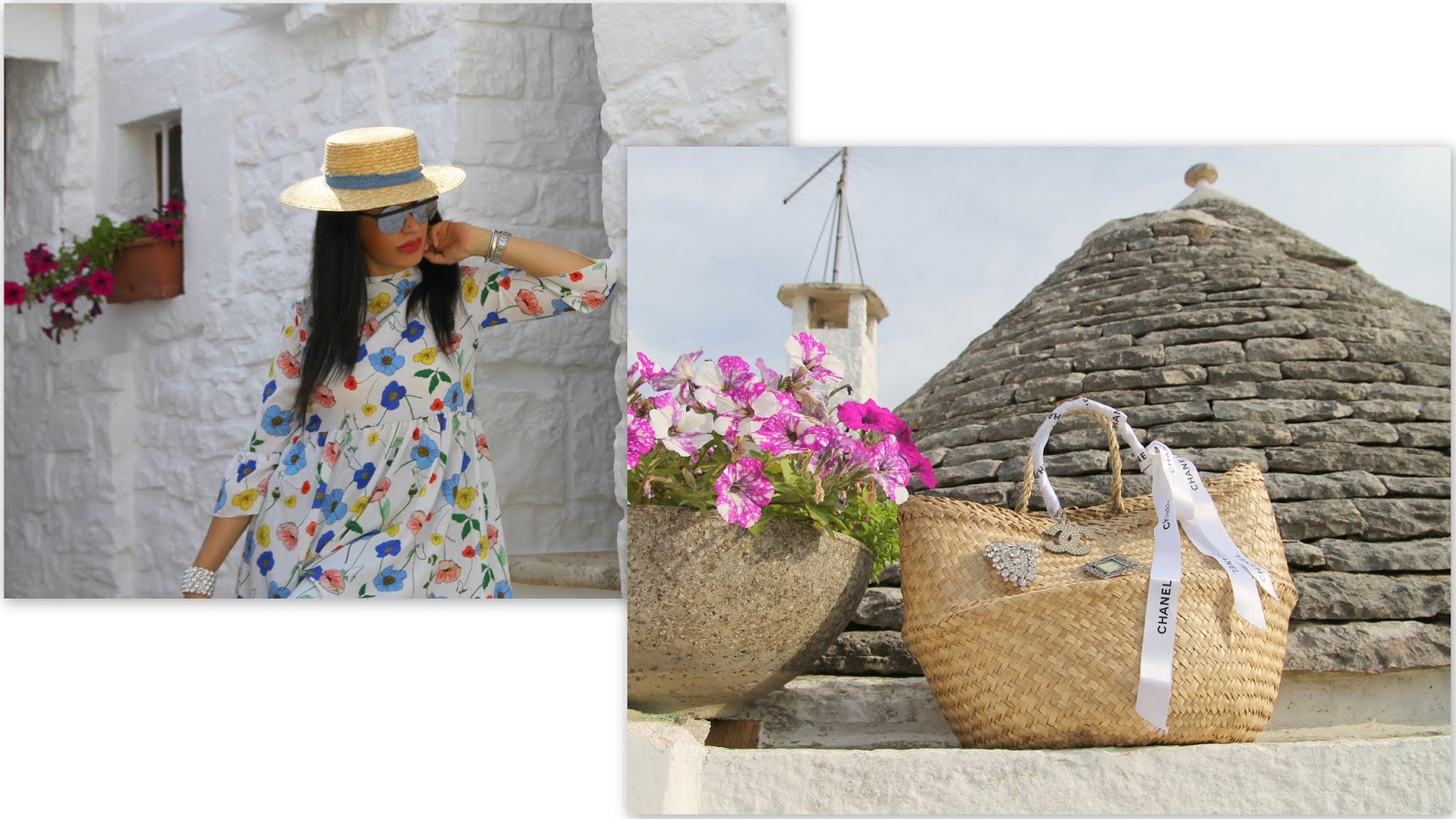



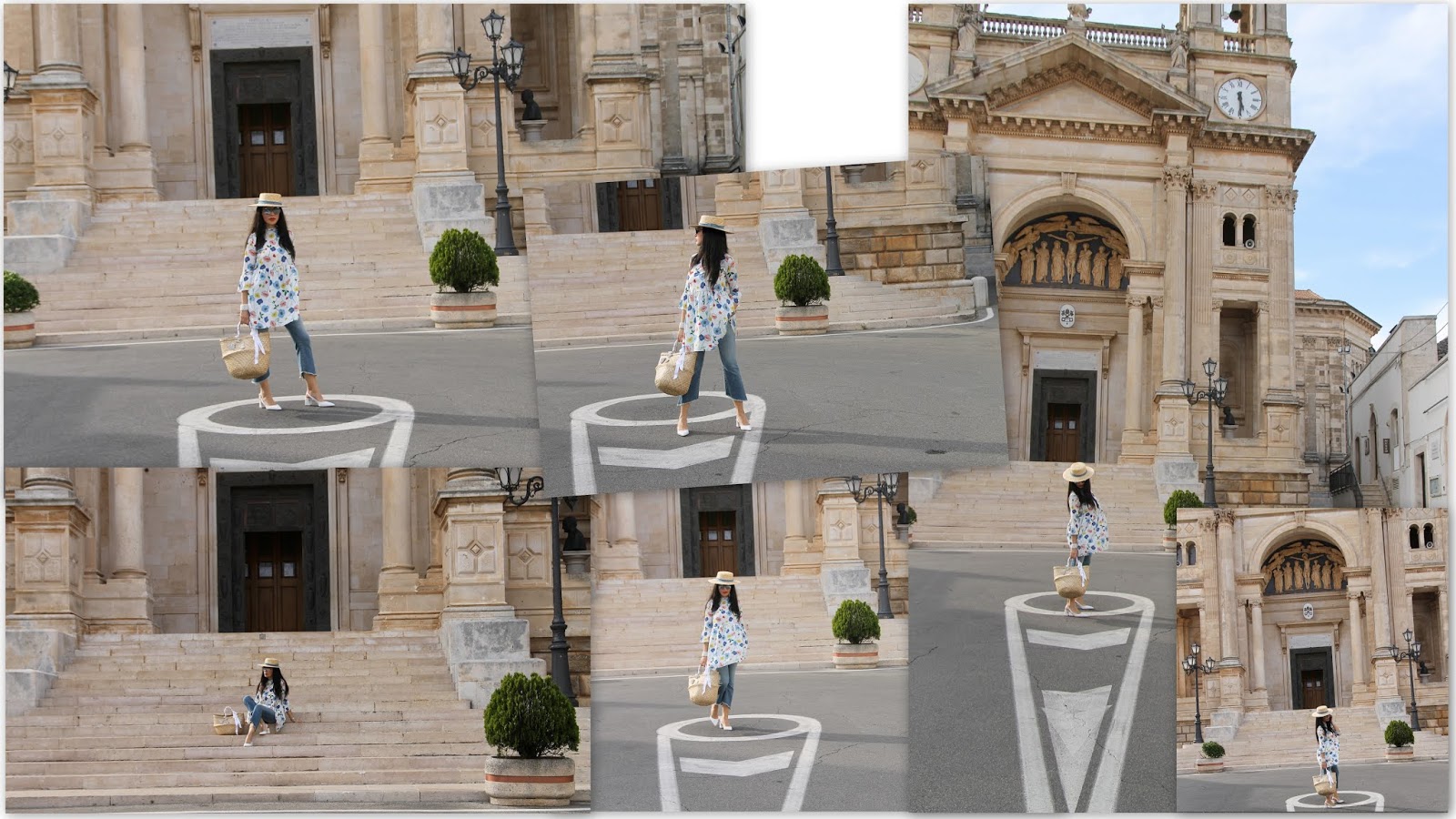

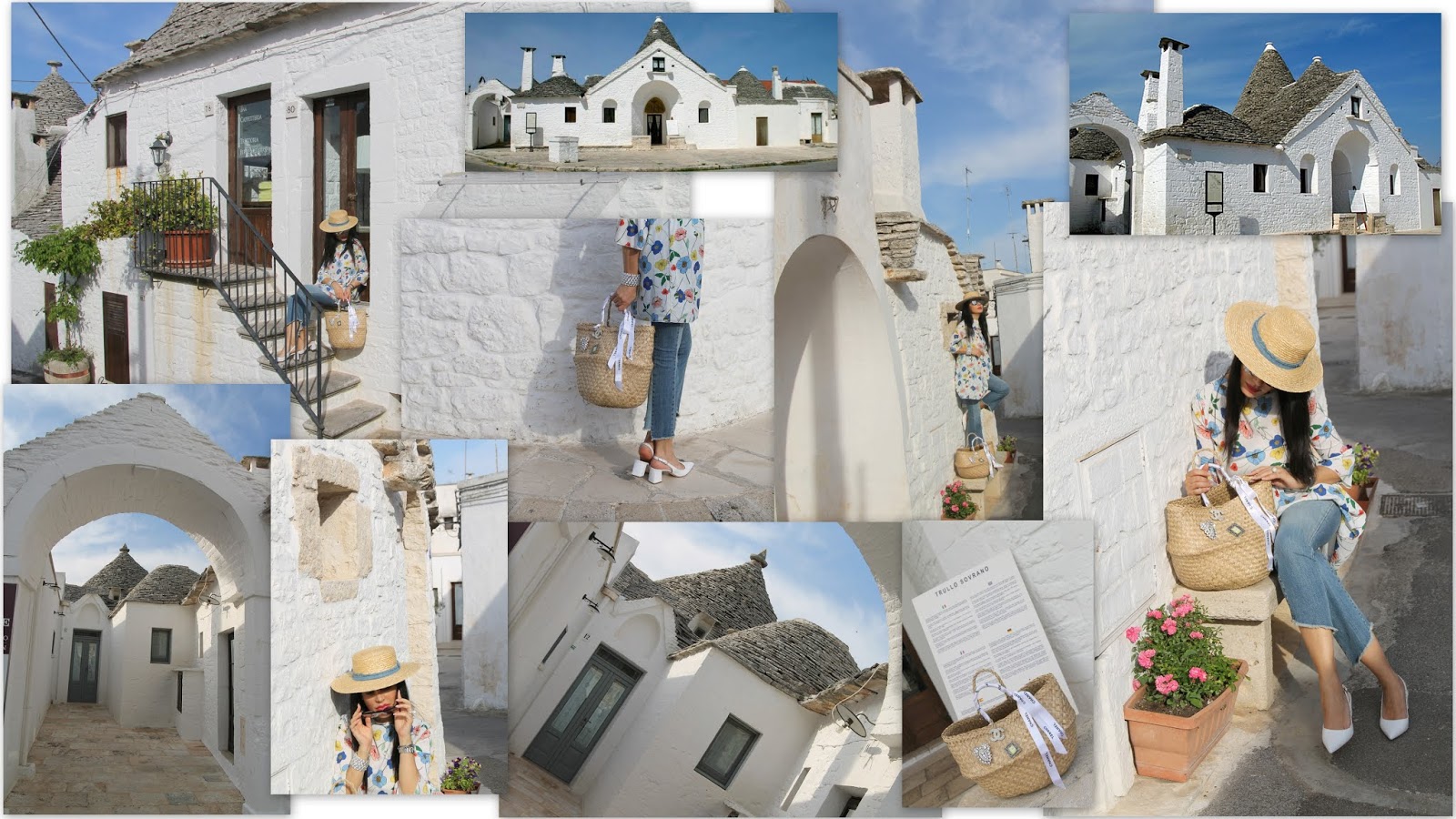
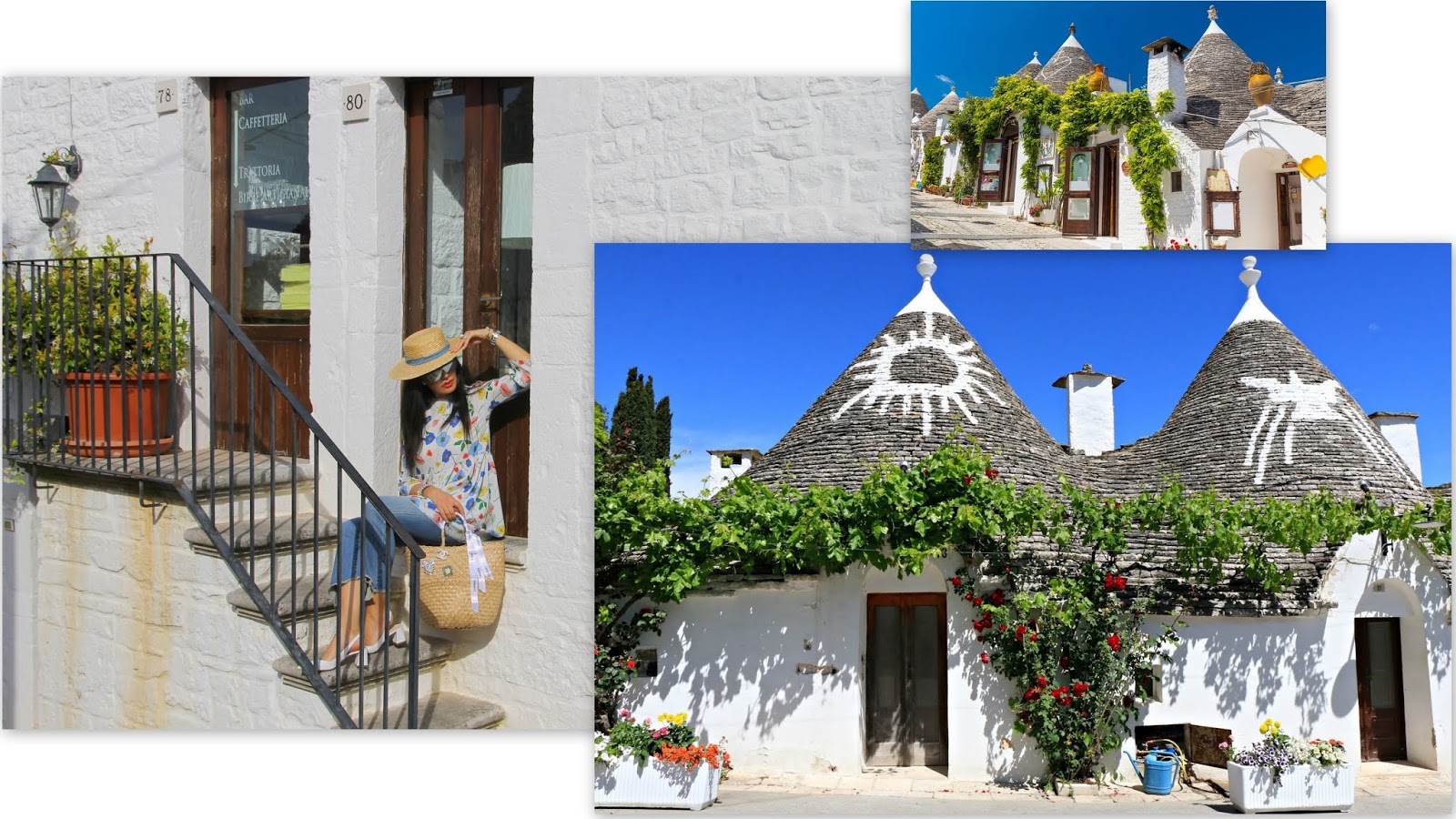
Photos:
Rita Graziano
I was wearing:
Camomilla dress
Topshop jeans
Cristian Leroy sunglasses
Chanel brooches
Konstantin Starke New York shoes


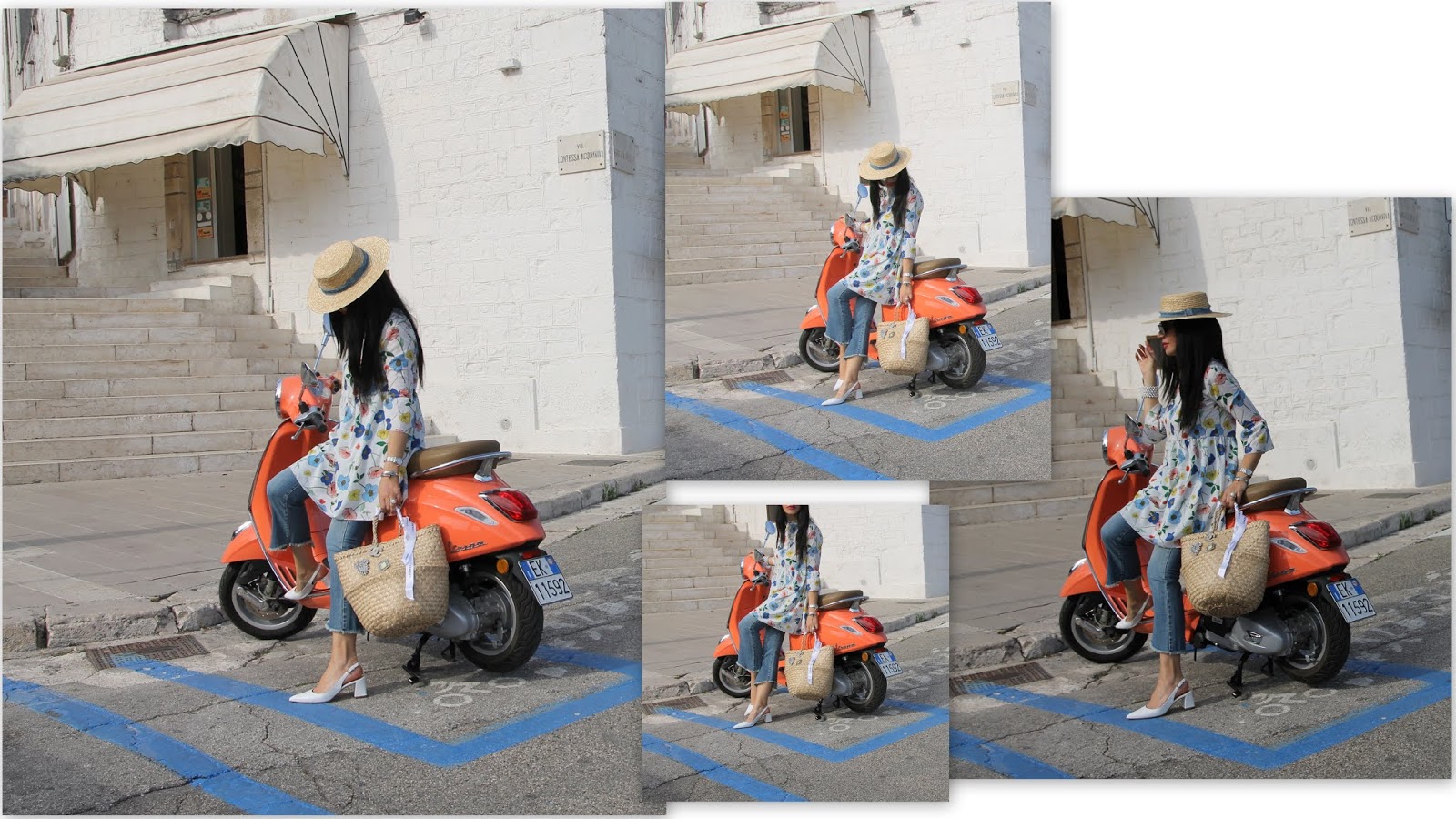

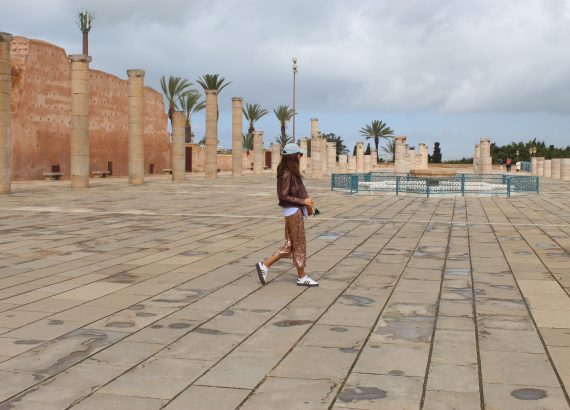
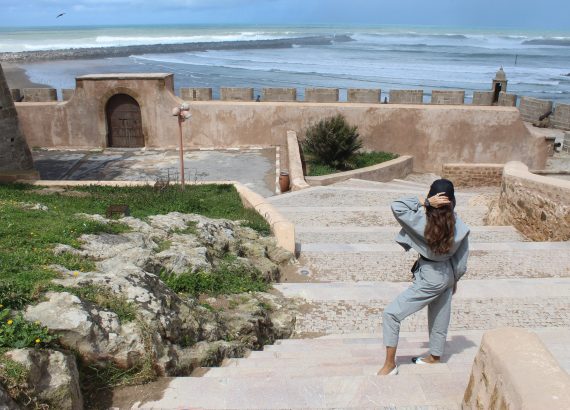
so nice post dear 🙂
http://itsmetijana.blogspot.com/
Ti ammiro e ti stimo perchè viaggi sempre in grande stile, perfetta dalla testa ai piedi. Quelli che si mettono la tuta da ginnastica e i calzini bianchi per visitare posti nuovi dovrebbero venire a leggere il tuo blog 🙂
http://www.scentofsummer.com
What an incredible place! You always choose the most wonderful spots to take your pictures. And of course, your outfit is stunning!
the-creationofbeauty.blogspot.com
You weren't kidding, it really does look like a fairytale! I'm in love!
I am loving the print of that dress. Very cute! Love the photos, you look cute. 🙂
A Shimmer, A Shadow
Super cute dress. You have me missing living in Europe.
http://www.amysfashionblog.com/blog-home
You are looking all kind of beautiful, Pola. I love that dress on you.
The trulli in Puglia, I have a wonderful memory … A very dry region in the summer but the heart of the people are so warm …
Superb photos
I love this dress
It's just so amazing to see a place like this! So beautiful! I'd like to go there as soon as possible! I just wonder about the furniture they have to use inside such houses … also everything has to be rounded? Tables as beds? 🙂 Great outfit of course but no surprise there Paola! Have a beautiful day xx
https://4highheelsfans.wordpress.com/2018/06/15/24-hours-in-amsterdam/
che bello questo piccolo paese! Abbinare gli jeans con un abito floreale e sempre una buona idea. Hai creato un look molto interessante e chic. Mi piace sempre il tuo stilo. Sei stupenda!!!!
Such a lovely place and cool outfit! Have a successful day dear!
xx
Paola ti devo copiare l'idea della borsa impreziosita, mi fa impazzire!
Kisses darling
Bellezza pour femme – fashion blog di Marzia Amaranto
Uuuaaauuu…que sitio mas bonito y curioso..y tú estupenda…un beso desde Murcia.
Love love that dress on you Paola. So beautiful and perfect.
Much love!
https://www.missymayification.co.uk
You look gorgeous ❤❤❤
Lovely outfit and lovely village, Paola!
That bag with beautiful brooches loos so cute and and chic!!
akiko
http://www.akikohiramatsu.com
Great post, love it!
Hope you can click on link at the end of my last post and if you want that we follow each other let me know 🙂
http://beautyshapes3.blogspot.com/2018/06/elegant-romper-outfit-zaful-part-1.html
Great post, love it!
Hope you can click on link at the end of my last post and if you want that we follow each other let me know 🙂
http://beautyshapes3.blogspot.com/2018/06/elegant-romper-outfit-zaful-part-1.html
Oh wow!! that place is amazing! and I really love your look!
xx
Eli
http://www.curly-style.com
Thanks a lot Eli, kisses!
This village is amazing, and you look perfect!
-Ashley
Le Stylo Rouge
I seriously like their architecture! ❀✿
Blog de la Licorne
Such a great place! I love the dress so much and the basket.
Have a lovely weekend ahead
Gemma x
http://www.jacquardflower.uk
Those pants are gorgeous 🙂 xx
http://www.fashionjazz.co.za
OMG I love those hat! You look stunning as always my dear!
I dyed my hair pink! Take a look to the entired tutorial
Luoghi incantevoli!!!
Nicoletta
https://www.lavieestbellebynicoletta.com
This village is a great place. Love your dress!
XX
http://www.elblogdebarbaracrespo.com/2018/06/single-breasted-front-dress/
Alberobello è veramente una stupenda città, come dici tu sembra uscita da una fiaba con elfi e gnomi. Adoro la tua scelta per l'outfit, chic, confortevole e intrigante, il capello è un tocco di gran classe.
Baci,
Flo
Thanks a lot for the interesting post) Have a nice weekend)
Thanks for stopping by doll!
It looks so pretty there! I love all the pictures you took.
http://sugarcoatedbears.blogspot.com/
Wow this place really does look like it’s somewhere out of a fairytale!
Wow, you look gorgeous in this outfit!
Have a good day!
http://www.recklessdiary.ru
Beautiful! Looks like a dream ♥
http://www.heresometimes.com
Thanks a lot 😀
amazing and fresh combo as usual 🙂
NEW TIPS POST | PROTECT YOUR HAIR IN THE SUMMER, BUT STARTS NOW!!!! :O
Instagram ∫ Facebook Official Page ∫ Miguel Gouveia / Blog Pieces Of Me 😀
estás preciosa hoyl!!!!! feliz día! un besazo! te espero en mi blog
http://www.ShoesAndBasics.com
This place looks like a fairy tale you look amazing as always my beautiful friend. Enjoy your weekend.
What a lovely place.
I love your floral blouse
and your pics look amazing.
Ann
https://roomsofinspiration.blogspot.com/
Bellissimo look da vacanza, sei super chic e adoro le scarpe! Baci
Fashion and Cookies – fashion and beauty blog
Such a lovely place, totally loved this look <3
Have a great day!
http://www.rakhshanda-chamberofbeauty.com/
carinissimo questo dress 🙂 buon weekend 🙂
Carmy
Sei uno splendore Paola!!
Ellysa
This is such a beautiful little village and I love all of the magical style buildings – it really does look straight out of a fairytale!
Heather xoxo
https://www.hefafa.me.uk
Thanks for visiting Heather!
xoxo
I´m so in love with your purse!!!
http://www.itzytrendy.com/2018/06/zaful-4th-anniversary.html
Gorgeous photos!
http://www.iameleine.com/
buon weekend!
Lovely pics!
Have a nice week-end!
Gil Zetbase
To me Italy has always been magical. I love the Aegean culture in general but Italy. That's a different story…
Love,
i.b. | http://soundslikeidil.blogspot.com
troppo bella Alberobello!! e tu sei stupenda!!
http://www.enricasciarretta.com
The place is so beautiful. great styling as well.
This has got to be one of my favorite looks of yours. I fell in love with it on Instagram. Very lovely!!!!!! The location is a dream!
https://www.fashionablyidu.com/
Beautiful shots as always, dear! xoxo